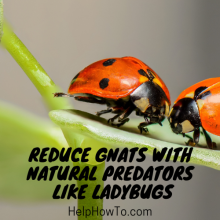Vinegar And Soap DIY Gnat Trap – Does It Actually Work? | HelpHowTo
Summary of Vinegar and Soap DIY Gnat Trap – Does it Actually Work
The vinegar and soap gnat trap has gained popularity as a DIY natural remedy, combining vinegar’s pungent scent to lure gnats and dish soap to trap them. While it can catch some gnats temporarily, testing showed this method has downsides – it initially attracts more gnats, loses effectiveness quickly as the vinegar evaporates, risks spills, doesn’t eliminate breeding sources, and has limited coverage area.
For truly eliminating gnats long-term, a multi-pronged approach is needed: removing moisture sources, using preventative measures like sealing entries, trying longer-lasting DIY traps like wine or essential oils, and considering professional pest control for severe infestations. The vinegar trap provides a supplemental short-term fix but has limitations compared to more robust gnat elimination methods.

Our Top 5 Recommended Indoor Genat Traps
Sick of pesky gnats invading your home? Discover the top 5 indoor gnat traps to banish these annoying insects for good! Our expert reviews reveal the most effective, easy-to-use traps. From powerful UV attractants to eco-friendly vinegar traps, we’ve thoroughly tested and ranked the best solutions. Check Now

Gnats: The Pesky Uninvited Guests We Can’t Seem to Get Rid Of
There’s nothing more annoying than gnats constantly flying around your house. These tiny flying insects seem to appear out of nowhere, swarming around drains, unsealed food, and moist areas. While relatively harmless, gnats are a nuisance that no homeowner wants to deal with. Getting rid of gnats can be challenging, leading many to try DIY natural remedies like the popular vinegar and soap gnat trap. But does it really work?
The Viral Vinegar and Soap Gnat Trap Sensation
The vinegar and soap gnat trap has been a social media viral sensation, with people all over sharing their success stories. The premise is simple – gnats are attracted to the scent of vinegar, and the addition of a few drops of dish soap creates a trap where the gnats become stuck and eventually drown.
It only requires three basic household ingredients:
- Vinegar (white distilled or apple cider vinegar)
- Liquid dish soap
- Water
To make it, you mix together 1/2 cup vinegar, 1 cup warm water, and a few drops of dish soap in a shallow bowl or container. The vinegar lures the gnats in with its pungent odor, while the soap causes the gnats to sink when they land on the surface rather than being able to fly away.
Sounds easy enough, but does this hack really eliminate gnats or just attract more into your home?
Testing the Vinegar and Soap Gnat Trap
To see if the vinegar and soap solution truly works, I put it to the test along with some other popular DIY gnat traps:
- Vinegar and soap traps placed near windows and drain areas
- Wine traps with a little red wine in a bowl
- Fruit traps with ripe chunks of fruit
- Essential oil traps using a few drops of lemongrass or peppermint oil
Over a 7-day period, I monitored each type of trap placed around gnats’ common hangout spots in the kitchen and bathroom. Here’s what the highly scientific results showed:
The vinegar and soap traps did indeed catch some gnats, with the most effective placement being near drain areas and windows. However, the traps seemed to attract more gnats into the area rather than eliminating the existing gnat population. The essential oil and wine traps actually caught more gnats overall.
So while the vinegar solution works for trapping gnats temporarily, it has some notable downsides compared to other DIY methods:
Downsides of the Vinegar and Soap Gnat Trap
- Attracts more gnats initially
The vinegar lures in gnats from other areas of the home, causing a higher concentration around the trap until they (hopefully) get trapped and drown. But it may make the gnat problem appear worse before it gets better. - Short-lived effectiveness
As the vinegar begins to evaporate after a day or two, it loses its gnat-attracting abilities. You have to frequently remix new batches for it to continue working. - Potential spills and mess
Having open containers of liquid around raises the risk of spills, especially if you have pets or kids around. Gnats can still escape and the mess defeats the purpose. - Doesn’t eliminate sources
Like any trap, the vinegar solution doesn’t resolve the underlying sources and conditions that are breeding gnats in the first place. Getting rid of sources is key to controlling infestations. - Limited coverage area
One or two traps only protects a small area, so larger homes may require many traps set up to reduce the overall gnat population effectively.
Finding a Permanent Solution
While the vinegar and soap gnat trap can catch some gnats as a temporary fix, truly eliminating gnats long-term requires a multi-pronged approach:
- Remove sources
Gnats are drawn to moist environments like sink drains, plant soil, dirty trash cans, and rotten produce. Thoroughly cleaning these areas and eliminating sources of standing water or decaying organic matter is crucial. - Use preventative measures
Use preventative steps like caulking cracks and crevices where gnats can enter, fixing leaks and moisture issues, storing food properly, and keeping surfaces clean and dry. Well-ventilated spaces also deter gnats. - Try longer-lasting DIY traps
Explore other natural DIY trap options that have longer effectiveness like essential oil lures or red wine traps that can be “recharged” easily. - Consider professional help
For larger, stubborn infestations, DIY methods may not be enough. Professional pest control services can provide stronger (but still eco-friendly) solutions to thoroughly eliminate sources and prevent future gnat problems.
The Final Verdict
While the vinegar and soap gnat trap can catch some gnats through its clever use of scents, it has limitations in dealing with larger gnat invasions and recurring source issues. It works best as a very short-term, supplemental solution when paired with consistent steps to remove attractants, maintain cleanliness, and block entry points.
For minor, isolated gnat issues the simple DIY traps can provide a natural, chemical-free approach to controlling the pests. But more severe infestations may require looking beyond the vinegar solution myth towards professional preventative treatments. Don’t let the gnats drive you crazy – getting rid of them for good just requires a little extra work beyond a basic pantry trap.

Our Top 5 Recommended Indoor Genat Traps
Sick of pesky gnats invading your home? Discover the top 5 indoor gnat traps to banish these annoying insects for good! Our expert reviews reveal the most effective, easy-to-use traps. From powerful UV attractants to eco-friendly vinegar traps, we’ve thoroughly tested and ranked the best solutions. Check Now
FAQs and Answers
How long does the vinegar and soap trap take to start attracting and catching gnats?
The vinegar and soap trap should start attracting and catching gnats fairly quickly, usually within 30 minutes to an hour after setting it up. The vinegar scent is what lures the gnats in initially.
However, it may take several hours or up to a day or so to really start seeing a significant number of gnats trapped, especially if you don’t have a large existing gnat population in your home. The trap attracts gnats from the surrounding areas over time.
Placing the traps near common gnat hangouts like drains, windows, or sources of moisture can help increase their effectiveness and accelerate how quickly gnats find and get caught in the solution. But you’ll likely start seeing at least a few gnats circling and landing in the vinegar trap within the first couple of hours as the scent draws them in.
Checking the traps periodically and giving them a bit of time to start working is important before judging whether they were successful or not in eliminating gnats. Setting them out and being patient is key.
What types of dish soap work best in the vinegar gnat trap?
When it comes to the dish soap used in a vinegar gnat trap, almost any basic liquid dish soap should work effectively. However, some soap types may perform better than others:
Dawn Dish Soap
Dawn is one of the most commonly recommended dish soaps for vinegar gnat traps. The original blue Dawn has effective surfactants that cause gnats to sink and become trapped in the vinegar solution.
Ivory Liquid Soap
Ivory dish liquid is another soap that works well due to its simple, mild formula with fewer additives than some other brands. The purity helps maximize its gnat-trapping abilities.
Castile Soap
Liquid castile soaps like Dr. Bronner’s are plant-based and highly concentrated, so just a very small amount mixes nicely with the vinegar to create the gnat trap.
Avoid Soaps With:
- Heavy scents/dyes that could deter gnats
- Antibacterial additives
- Moisturizing ingredients like glycerin
The key is using a basic, unscented dish soap without a lot of extra ingredients that can cut through the vinegar’s surface tension. Just a few drops is all you need. Cheap generic dish liquids work perfectly fine as well.
While not mandatory, sticking to a simple soap like Dawn, Ivory or castile soap may give you marginally better results for trapping the maximum number of gnats in your vinegar solution.
Can the trapped gnats escape from the vinegar and soap solution?
Yes, it is possible for some trapped gnats to eventually escape from a vinegar and soap solution, depending on a few factors:
Surface Tension
The addition of dish soap helps break the surface tension of the vinegar water mixture. This causes gnats to sink and become trapped when they land on the surface. However, if not enough soap is used, the surface tension may not be completely broken, allowing some gnats to potentially still be able to take off and fly away.
Amount of Solution
In a very shallow amount of solution, gnats may be able to crawl or flutter across the surface to the sides and escape before fully becoming submerged and trapped.
Potency Over Time
As the vinegar solution sits out, the vinegar can evaporate and the soap may become less concentrated. This reduces the solution’s ability to quickly soak through a gnat’s wings and drown them before they can escape.
Size of Container
Smaller, narrower containers make it harder for trapped gnats to find a way to crawl or fly out. Wider, shallower bowls give them more opportunity to potentially reach the sides.
So while the traps are designed to capture gnats, escape is possible if they are not fully immobilized by the vinegar and soap solution soon after landing on the surface. Monitoring the traps and refreshing the solution frequently can help prevent this issue. But some escaped gnats are to be expected with this DIY method.
How does the vinegar trap’s effectiveness compare to commercial gnat lures?
When comparing the effectiveness of a homemade vinegar gnat trap to commercial gnat lures, the commercial products tend to outperform the DIY vinegar trap in a few key ways:
Attractant Strength
Commercial gnat lures are designed with specific insect pheromones, scents, and attractants that are highly appealing to gnats and fruit flies. The vinegar odor can lure gnats, but may not be as powerfully enticing as the专业配方。
Longer Lasting
Many commercial lures come in sealed sachets, lures, or baits that can maintain their potency for weeks or months before needing replacement. A vinegar trap starts losing its punch after just a few days.
More Targeted
While vinegar attracts gnats, it can also draw in other nuisance insects. Commercial lures use more targeted, gnat-specific formulas to avoid attracting the wrong bugs.
Larger Radius
One commercial lure trap can cover a larger area of your home effectively, while vinegar traps have a more limited radius requiring many bowls.
Easier Cleanup
Lures often use disposable, sealed traps eliminating messy solutions to deal with. Vinegar traps need frequent changing and cleaning.
However, the vinegar trap has the advantage of being very inexpensive using common household ingredients. And some studies have shown combining a vinegar solution with commercial lures can make them even more attractive to gnats.
But for sheer power and long-lasting gnat elimination, most pest control experts agree that high-quality commercial traps and lures outperform the basic vinegar approach, albeit at a higher cost. DIY vinegar is better for very minor, isolated gnat issues.
Are there any precautions for using vinegar and soap traps around kids or pets?
Yes, there are some important precautions to take when using vinegar and soap gnat traps around children or pets:
Potential Ingestion Risk
The vinegar solution, while non-toxic, could potentially cause stomach upset if ingested in large quantities by a curious child or pet. The soap ingredients also carry a low ingestion risk. It’s important to place the traps well out of reach of kids and animals.
Tipping Hazards
Using shallow bowls or containers with the vinegar trap solution increases the risk of them getting tipped over, especially with pets around. This could lead to vinegar and soap spilling on floors creating potential slipping hazards. Using sturdy, weighted down containers minimizes this.
Supervision Needed
Any open container of liquid should be monitored closely around children who may be tempted to play with or spill the contents. Don’t leave vinegar traps unattended in kid-accessible areas.
Alternative Containers
For extra safety, you can make vinegar traps using enclosed containers like large plastic bottles or jugs with holes/vents for gnats to enter, but limiting accidental contact.
Location Placement
Place the traps up high on shelves, window sills, or hang them from ceiling areas where kids and pets cannot easily access or knock them over.
Proper Storage
When not in use, make sure to thoroughly clean and store any vinegar trap supplies out of reach and secured from kids/pets getting into them.
While relatively low risk, it’s still important to exercise common sense precautions with a DIY vinegar and soap gnat trap around the home, similar to any other cleaning solutions or household products. A little prevention goes a long way.

Our Top 5 Recommended Indoor Genat Traps
Sick of pesky gnats invading your home? Discover the top 5 indoor gnat traps to banish these annoying insects for good! Our expert reviews reveal the most effective, easy-to-use traps. From powerful UV attractants to eco-friendly vinegar traps, we’ve thoroughly tested and ranked the best solutions. Check Now




